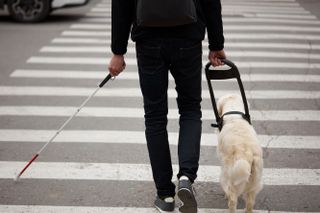Smart cane helps guide the visually impaired
The cane uses ultrasound to detect obstacles and pairs with smartphones

The canes used by visually impaired people are getting a high-tech makeover.
A new “smart cane” detects obstacles with ultrasound, but that’s not all. Users can also pair the cane with a smartphone to give them information about shops and restaurants they’re passing.
This state-of-the-art cane is the work of Kursat Ceylan, a Turkish inventor who was born blind.
Ceylan, 35, was inspired to invent the smart cane after being injured three years ago in an accident that left him scarred.
Ceylan was visiting New York for a United Nations meeting and was struggling to navigate the city streets. He was checking GPS directions with his smartphone while also holding his white cane and pulling a suitcase behind him when he hit his head on a sign.
After the injury, Ceylan helped found WeWALK, a tech company that created an electronic handle for the top of a cane. The handle uses ultrasound to detect obstacles and pairs with a smartphone to give voice feedback and help keep its visually impaired user safe and informed.
“We are providing an opportunity to visually impaired people to be a part of the social life,” Ceylan told Reuters at the Mobile World Congress in Barcelona, where his company is competing for the title of “best impact startup.”
Get the ITPro. daily newsletter
Receive our latest news, industry updates, featured resources and more. Sign up today to receive our FREE report on AI cyber crime & security - newly updated for 2024.
Thousands of visually impaired people in nearly 60 countries use his company’s $599 foldable cane, Ceylan said. He added that WeWALK is collaborating with Microsoft and other companies to add more features.
“As you know, we are thinking about fully autonomous vehicles,” Ceylan said. “WeWALK is a device to provide a fully autonomous blind journey to visually impaired people.”
Recently, many technological advances have been harnessed to help visually impaired and blind people navigate the world.
Last year, the cloud communications platform Twilio revealed it’s powering Be My Eyes, an app for the visually impaired.
Be My Eyes pairs cameras and video chat to help 178,000 visually impaired people get help from more than three million volunteers. For example, the user can point the camera at a sign, document, or even food packaging so the remote volunteer can read it out.
The chat function can also be used with companies that support the app, including Microsoft, Google and Lloyds Banking, making it easier for visually impaired people to get help using their services.




